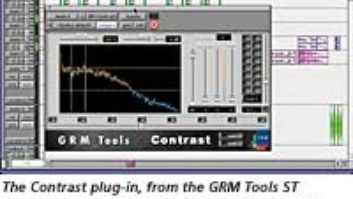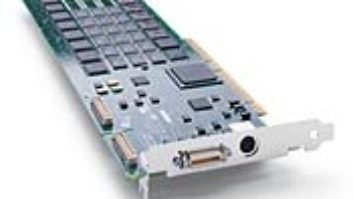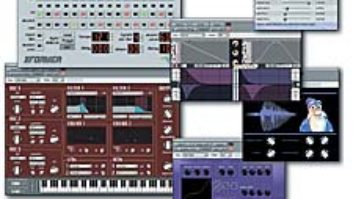The GRM Tools plug-in bundle was created by the Groupe de Recherches Musicales de l’Institut National de l’Audiovisuel (aka, Ina-GRM) in Paris. The bundle consists of eight mind-warping plug-ins that are the culmination of more than 15 years of R&D.
GRM Tools is available in three different flavors: VST, RTAS and TDM. The plug-ins are identical in the RTAS and VST versions: Band Pass, Comb Filter, Pitch Accum, Shuffling, Delay, Doppler, Freeze and Reson. (The first four make up Volume 1, and the second Volume 2 of the VST bundles.) However, the TDM bundle replaces Reson with Equalizer.
Electronic Music Foundation (Albany, N.Y.) distributes the TDM and RTAS versions of the bundle ($459 and $349, respectively). The VST version is distributed by Steinberg, and instead of one bundle with eight plug-ins, there are two bundles of four plug-ins each. These retail separately for $199. This field test focuses on the TDM bundle (Version 1.3).
Installing the GRM Tools bundle is routine. Pop the CD-ROM in your computer and hit Install. All of the plug-ins are installed in the Plug-Ins folder of your DAE folder. You get two weeks to try out the plug-ins before you need to authorize them. Copy protection is by challenge/response. The response can be obtained via e-mail, phone or fax.
UNIVERSAL CONTROLS
Each plug-in format sports its own GUI look, and every plug-in has its own set of unique parameters, but they also have several common control elements that make the GRM Tools especially powerful for sound design and serious audio morphing tasks, because they allow multiple parameters to be changed simultaneously. There are four elements: a preset bar with 16 individual program keys, a long horizontal fader dubbed a Super Slider, a rate of change control and something that’s best described as a 2-D potentiometer. All of these features can be automated in Pro Tools fashion except the 2-D potentiometer.
The preset bar lets you save and load patches to any of its 16 keys. These patches are in addition to the Pro Tools plug-in window’s save and load feature. In fact, saving and loading presets through the Pro Tools menu recalls all of the plug-ins’ internal patches. The ability to have 16 patches at the click of a mouse without the hassle of pop-up menus is excellent; it really makes group parameter changes quick and easy.
By clicking on a preset bar key, the rate at which the current parameters change to the new parameters can be set from zero to an ample 30 seconds. Interpolation time is adjusted by using an associated vertical fader or by entering a value directly into the text field just below the fader. Set the interpolation time to a value above zero, click on a preset key and watch the plug-ins’ parameters morph.
The Super Slider lets you manually control interpolation times between specific presets. Directly above the Super Slider are eight keys that address any of the plug-ins’ 16 internal patches, giving you the option of arranging a group of eight patches in any order. By using the Super Slider you can manually morph between the selected presets at any rate, forward or backward — super cool.
The 2-D potentiometer consists of a small square element that you can drag around, vertically and horizontally, in a window. Moving the element lets you change the relative values of two preset parameters. For example, in the Band Pass plug-in, it controls the high and low cutoff frequencies. The parameters that are tied to the potentiometer are usually located directly above or below its window. These parameters can be precisely monitored, because the associated text fields’ values change as you move the potentiometer. Automating the potentiometer would be sweet, but because this isn’t possible, I found the potentiometer useful mainly as a tool for writing new patches. The potentiometer is found on all of the plug-ins except the Comb Filter and Equalizer.
PLUG-IN LINE UP
All of the plug-ins are available in either mono or stereo versions. The Delay, Doppler, Freezing, Pitch Accum and Shuffling also do mono to stereo. Every plug-in has input gain attenuation, and all but Doppler, Pitch Accum and Shuffling have an output level meter. Though the RTAS and VST versions of the plug-ins have a wet/dry mix control, the TDM plug-ins do not — a major bummer. I hope Ina-GRM fixes this in the near future.
The Comb Filter comes in 1- and 5-band versions. There are frequency, resonance and lowpass parameters. The 5-band version offers five discrete filters for each of the above-mentioned parameters along with a master. Comb Filter is a great plug-in for dramatic filter sweeps and resonant effects. I really enjoyed processing synth pads by automating the effect in time to a beat — great for dance music.
There aren’t a lot of parameters on Band Pass, but what’s there sounds really good. You get frequency and bandwidth controls, and a key for selecting between either bandpass or band-reject operation. The low and highpass faders have 512 steps, from 23 to 22k Hz, and are excellent for honing in on the desired filter effect. Using the potentiometer to sweep these two parameters at the same time is great fun and perfect for tailoring sounds to picture.
Equalizer is a graphic equalizer and has 23 fixed bands, equally spaced at ⅓-octave bands from 40 to 13k Hz. The Super Slider and Interpolation controls make this plug-in more flexible than your average graphic EQ. The Equalizer Pro Tools Mix|24 version is designated as Equalizer Mix.
There is also a Mix|24 version of Delay, Delay 24. This plug-in offers up to 24 delay lines (the RTAS and VST versions do up to 128 delays — if your computer has the processing power, of course), and there are several unique control parameters. You can adjust the number, distribution (how the delays cluster) and amplitude envelope of the delays. The potentiometer controls the delays’ ranges (0 to 683 ms) and when the first delay is heard (out to 683 ms). There is the ubiquitous feedback parameter and a fader to introduce random variations in the delay lines. Below the potentiometer is a discrete window that shows exactly how the delays are falling; it’s very useful for visualizing the outcome of your tweaks. If delay lines are your thing, then Delay 24 can help with many of your more creative jobs.
There’s nothing quite like Doppler to simulate a sound moving through space. As its name implies, this plug-in allows you to create a Doppler effect — it’s quite convincing. You can control the sound’s passing speed, amplitude change and pitch change for that perfect drive-by every time. Additionally, radical movements can be cooked up, including rotating a sound around a central position and simultaneously moving it through the stereo field. (Imagine a fly buzzing around your head as you run madly away trying to escape it.) The potentiometer gives you manual control over the sound’s position in the stereo field on X and Y axes. Automate this plug-in’s parameters and pop on some headphones for a real trip.
Freeze is probably Ina-GRM’s best-known plug-in, most likely for its extreme sound mangling capabilities. You can sample up to 99 ms, select a loop from the sample and have as many as eight loops going at once. (In the RTAS and VST versions, you can grab up to 3 seconds and have as many as 32 loops.) Parameters include synchronizing loop playback, pitch change and randomizing pitch and loop duration. The potentiometer in Freeze is a wonderful tool to adjust loop start and end points. But don’t think Freeze is a typical loop playback machine; individual loops are not adjustable. For example, when you choose a number of loops to work with, they are all on at once, that’s it. Freeze’s tuning and randomizing parameters are what create the complex and off-beat layered sounds it’s known for. This plug-in is a difficult fit for musical applications, but makes crafting sound effects a piece of cake.
Initially, Shuffling sounds similar to Freeze. But instead of looping a section of the audio, Shuffling plays fragments (up to 683 ms, or 2937 ms with the RTAS and VST formats) of the source track. There is control over the duration, pitch, delay before playback and how often the fragments play. A simple amplitude envelope can be superimposed on the fragments, and feedback is also available. At its extremes, Shuffling sounds like a random stereo gate with a wildly pitch-shifting source to really nasty radio static. This plug-in is another shoe-in for the audio mutilation awards.
The Pitch Accum is like a harmonizer on LSD. With two discrete pitch shifters, it’s possible to cook up some decent harmony parts. You can transpose up or down 24 semitones, there are periodic and random modulation parameters, and harmony parts can be delayed up to 671 ms. And much stranger sounds can be concocted. Using the feedback, feedback mix, and a transposed sound’s duration and blend parameters, a vocal performance is easily turned into an out-of-control, sci-fi phaser battle. While I wasn’t blown away by the quality of Pitch Accum’s harmony parts, they can work with the right track. This plug-in’s bizarre effect possibilities are the real attention grabbers.
ENDLESS CHOICES
There are a ton of wonderful sonic possibilities with the GRM Tools bundle. And the plug-in’s unique controls really help get the most out of these processors. Bear in mind that all these neat effects do come at a heavy DSP cost. A single instance for most of these plug-ins eats up 50 to 100% of one Mix DSP chip. Got power? You’ll need it if you start stacking up Delay 24 and Shuffling plug-ins.
Looking at how much other TDM bundles with multiple plug-ins cost makes you realize what an outstanding value the GRM Tools bundle is. However, if what you are looking for is a bundle of work — a day-to-day, utility-type plug-in — then the GRM Tools pack probably isn’t for you. There are a lot of very creative plug-ins that are the cat’s meow for sound design and dance music production, but these plug-ins won’t get you through a basic tracking session. Reserve the GRM Tools plug-ins for when you really want to expand your sonic palette, and you won’t be disappointed.
The GRM Tools TDM and RTAS bundles are distributed by Electronic Music Foundation, 116 North Lake Ave., Albany, NY 12206; 888/749-9998; fax 518/434-4110; www.grmtools.org.
Erik Hawkins is a musician/producer working in Los Angeles County and the San Francisco Bay Area. Visit him atwww.erikhawkins.comfor more equipment chitchat and tips on what’s hot for the project studio.




